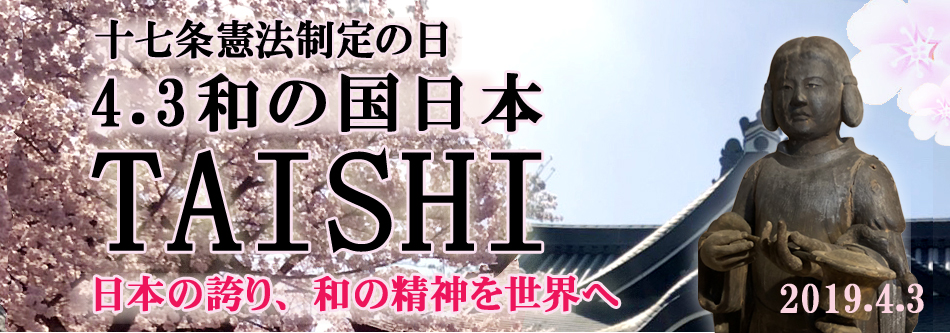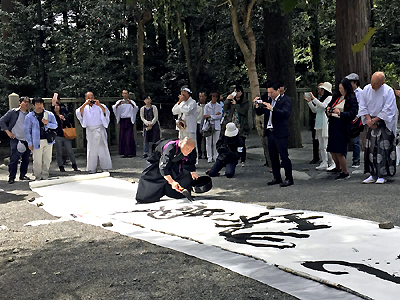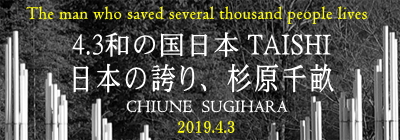 |

World Peace Prayer at Temple on April 3rd, 2019
KIGO held by the Japanese calligraphers
We will be waiting to meet you at KIGO sites, to pray for world peace with
all of you.
Administration fee is free./ No advanced reservation is required.
Organization: WA Project TAISHI
|
|
|
 About us About us |
| “WA Project TAISHI” is a volunteer-based non-profitable
organization to achieve peace throughout the world by introducing Japanese
traditional culture both at home and abroad. |
|
|
|
 What is KIGO? What is KIGO? |
Sekijyo-KIGO, commonly known as “Calligraphy Performance”
performed by a Calligrapher in front of an audience is a traditional Japanese
Spiritual Culture similar to Zen. When the calligrapher writes a word,
phrase or wish chosen from their heart on a large paper, the audience’s
attention gathers towards the Calligrapher’s appearance and the tip of
their brush. Just like a conductor in an orchestra putting together a symphony,
a Calligrapher makes everyone’s feelings come together, which strengthens
the feelings of prayer. This times opportunity will make everyone’s mind
look towards world peace, harmony of the world, and the tolerance of spirit.
A Calligrapher wearing Kimono will write a message of world peace and Wa
Spirit.
|

< MOVIE > |
|
|
 Japanese Buddhism and Prince Shotoku (Shotoku Taishi) Japanese Buddhism and Prince Shotoku (Shotoku Taishi) |
Buddhism was introduced to Japan in 538 A.D.
A legend says Prince Shotoku who established the basis of Japan as a nation spread its teaching 1400 years ago. Since then the Japanese people have had a syncretic relationship between Buddhism and Shintoism.
Shintoism holds a kind of belief that all creatures including non-living
materials have their own spirits as well as incorporating animism similar
to other ancient shamanistic belief system of the world. Therefore people
in Japan have also been very tolerant and respectful to spirits of the
other religions.
There are some good examples. First, we can see some Buddha statues in
Shinto shrines, shrine gates in Buddhist temples, and also surprisingly
Jesus or Virgin Mary statues devoted by Japanese immigrants in Shinto shrines
in Brazil.
However, 150 years ago, when a new government completed
Meiji Restoration, people became more nationalistic, and a good old mixture
between Buddhism and Shintoism totally collapsed and separated. The government
tried to make Shintoism a state religion, and on the other hand, Buddhism
and Buddhist temples were rejected by the government.
After World War Ⅱ, the Japanese government completely rejected state religion, and Shintoism has returned to its syncretic.
Now, most people visit shrines to pray for happiness
in new year days and temples to pray for their ancestors in August, and
celebrate Christmas in December. It is quite unique or strange for people
in the world but not for Japanese.
Japanese culture consists of tolerance which is called
“WA Spirit” established by Prince Shotoku. People always try to acquire
good points from the other religions or cultures rather than just keeping
tradition or original beliefs. This particular aspect is the most important
point of Japanese culture.
April 3rd is the date when Prince Shotoku established
The Seventeen Article Constitution based on “ WA Spirit.”
There are mainly 13 sects in Japanese Buddhism now. They are mostly the same but different in some parts. This great calligraphy show is to pray for world peace with many sects of Japanese Buddhist temples simultaneously.
|
|
|
 Venue Venue |
| |
updated on 3/31
| Temple |
City & Map |
Calligrapher |
Start time |
| Banryuji |
Iwate |
MATSUMOTO Hirofumi |
10 : 00 |
| Rinnoji |
Tochigi |
ONOZAKI Keita |
14 : 00 |
| kokujouji |
Niigata |
SHIMODA Saisui |
11 : 00 |
| Seitokuji |
Fukui |
JYAKURIN |
13 : 00 |
| Enkoji |
Gifu |
SHIMADA Sumi / Eigetsu |
14 : 30 |
| Rakuunji |
Nagoya |
SHIDA Kirei |
10 : 30 |
| Shinpukuji |
Okazaki |
OGAWA Reigetsu |
10 : 00 |
| Shitennō-ji |
Tsu |
ITO Junichi |
11 : 00 |
| Saikyoji |
Otsu |
KANDA Kozan |
14 : 00 |
| Sekiganji |
Tamba |
ARAI Houyo / MUKAI Takumi |
13 : 00 |
| Tachibana-dera |
Nara |
SENSYU Yasuko |
14 : 00 |
| Hokaiin |
Okayama |
SHIYO |
11 : 00 |
| Jodoji |
Hiroshima |
TORYU Hauna |
14 : 00 |
| Taisanji |
Ehime |
HAYASHI Ryuho |
10 : 00 |
| Taiheiji |
Ehime |
HAYASHI Ryuho |
14 : 00 |
| Kanzeonji |
Fukuoka |
SUGITA Koki |
11 : 00 |
| Kofukuji |
Nagasaki |
SATOU Hosui |
11 : 00 |
| Syofukuji |
Nagasaki |
SATOU Hosui |
14 : 00 |
| Fukiji |
Oita |
MATSUMOT Shigeyuki |
10 : 00 |
|
| |
 |
|
| |
 |
| |
| © WA Project TAISHI. All Rights Reserved. |




